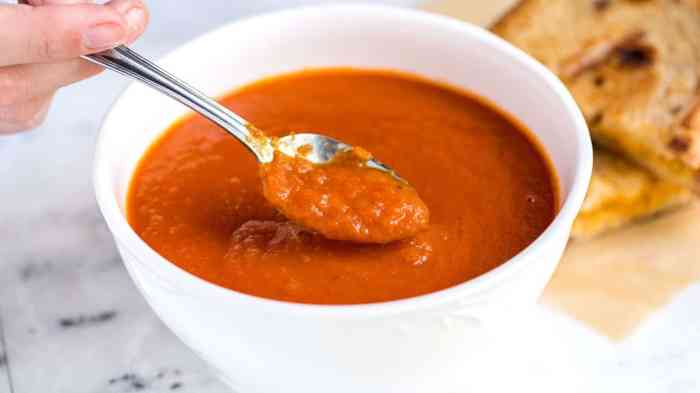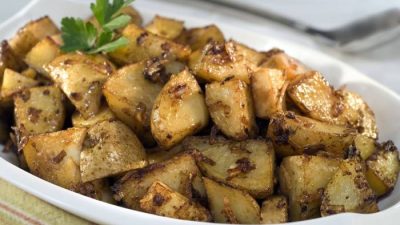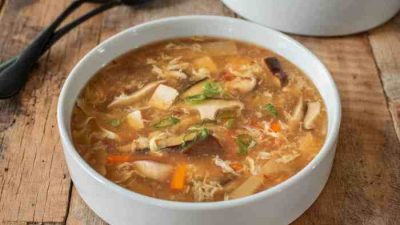Tomato Soup: A Culinary Exploration: Recipe Of Tomato Soup
Recipe of tomato soup – Tomato soup, a seemingly simple dish, offers a world of flavor possibilities. From classic comfort food to sophisticated culinary creations, its versatility lies in the diverse ingredients and cooking techniques employed. This exploration delves into the various aspects of tomato soup, from its diverse variations and nutritional profiles to creative serving suggestions and recipe customizations.
Tomato Soup Variations

Source: bonappetit.com
The spectrum of tomato soup extends far beyond the basic canned variety. Different tomatoes, broths, and additions create unique flavor profiles. Below are five distinct recipes, each with its own character.
| Recipe Name | Key Ingredients | Preparation Time | Description |
|---|---|---|---|
| Creamy Tomato Soup | Ripe tomatoes, heavy cream, vegetable broth, onion, garlic | 45 minutes | A rich and luxurious soup, perfect for a chilly evening. The cream adds a velvety texture and enhances the sweetness of the tomatoes. |
| Spicy Roasted Tomato Soup | Roasted tomatoes, chipotle peppers in adobo sauce, vegetable broth, cumin, cilantro | 1 hour | Roasting the tomatoes intensifies their flavor, while the chipotle peppers add a smoky heat. The cumin and cilantro provide complementary earthiness and freshness. |
| Basil Tomato Soup | Fresh tomatoes, fresh basil, vegetable broth, garlic, olive oil | 30 minutes | A vibrant and herbaceous soup, perfect for a light lunch or starter. The fresh basil adds a bright, peppery note that complements the sweetness of the tomatoes. |
| Classic Tomato Soup | Canned tomatoes, onion, carrots, celery, vegetable broth | 30 minutes | A simple and comforting soup, perfect for a quick weeknight meal. The combination of onion, carrots, and celery provides a savory base for the tomatoes. |
| Tomato Soup with Coconut Milk | Ripe tomatoes, coconut milk, ginger, lemongrass, vegetable broth | 45 minutes | This soup offers a unique twist with the addition of coconut milk, which adds a creamy texture and subtle sweetness. The ginger and lemongrass provide a fragrant and exotic touch. |
The cultural origins of tomato soup are diverse. Classic tomato soup, utilizing canned tomatoes and basic vegetables, reflects the practicality and resourcefulness of American cuisine, adapting to readily available ingredients. Spicy roasted tomato soup finds its roots in Mexican cuisine, where the use of chiles and spices is integral to many dishes. The addition of basil, a key ingredient in the Basil Tomato Soup, reflects Italian culinary traditions, where fresh herbs are widely used to enhance the flavors of simple dishes.
Comparing a classic tomato soup recipe (using canned tomatoes and chicken broth) to a vegan version (using vegetable broth and omitting dairy), the nutritional content differs significantly. The vegan version is naturally lower in saturated fat and cholesterol. However, the classic version may offer more vitamin B12 if the chicken broth is made with bone-in chicken. Both versions can be excellent sources of lycopene, an antioxidant found in tomatoes, beneficial for health.
The nutritional content can also be further enhanced through the addition of vegetables and legumes.
Ingredient Exploration

Source: inspiredtaste.net
The choice of tomatoes significantly impacts the final product. Roma tomatoes, with their meaty texture and rich flavor, are ideal for roasting and creating a concentrated taste. On the other hand, heirloom tomatoes, known for their varied colors and sweetness, lend a more complex and nuanced flavor profile to the soup. Using canned tomatoes offers convenience, while fresh tomatoes provide a superior flavor, though it requires more preparation.
The broth plays a crucial role in enhancing the soup’s flavor. Chicken broth adds a savory depth and richness, while vegetable broth provides a lighter, more neutral base. Beef broth imparts a bolder, more intense flavor, suitable for heartier variations. The choice of broth depends on personal preference and the overall flavor profile desired.
A simple tomato soup recipe often features roasted tomatoes for a deeper flavor. For a heartier meal, consider pairing it with something richer, like the pork chop rice and cream of mushroom soup recipe , which offers a delightful contrast. Returning to the tomato soup, you can easily adjust the recipe’s thickness by simmering longer or adding a touch of cream.
Adding ingredients can boost the nutritional value of tomato soup.
- Lentils: Add protein and fiber.
- Spinach: Boosts vitamins and minerals.
- Quinoa: Increases protein and complex carbohydrates.
Cooking Methods and Techniques
Making a simple blended tomato soup is straightforward.
- Sauté onions, garlic, and carrots until softened.
- Add canned tomatoes, broth, and seasonings.
- Simmer for 15-20 minutes.
- Blend until smooth.
- Serve hot.
Roasted tomato soup offers a deeper, more intense flavor. Roasting the tomatoes at high heat (400°F/200°C) for about 30-40 minutes caramelizes their sugars, resulting in a sweeter and more complex taste. This process concentrates the tomato’s natural sweetness and creates a smoother texture when blended. Adding herbs like thyme or oregano during roasting further enhances the flavor profile.
Tomato soup made with fresh tomatoes generally possesses a brighter, more vibrant flavor and a slightly thinner consistency compared to the soup made with canned tomatoes. Canned tomatoes, due to the processing, tend to yield a richer, more concentrated flavor, often with a slightly thicker consistency.
Serving and Presentation, Recipe of tomato soup
Garnishes elevate the visual appeal and flavor of tomato soup.
- A swirl of fresh cream or coconut milk adds richness and visual texture.
- Chopped fresh basil or parsley provides a pop of color and fresh herbal notes.
- A drizzle of high-quality olive oil adds a luxurious touch and subtle fruity flavor.
Serving tomato soup creatively enhances the dining experience. Serving it in crusty bread bowls transforms it into a hearty meal. Chilled tomato soup, served with a dollop of crème fraîche, offers a refreshing summer option. A grilled cheese sandwich pairs perfectly with a bowl of warm tomato soup, creating a classic and satisfying combination.
Imagine a vibrant red bowl filled with a velvety smooth tomato soup. The color is a deep, rich crimson, reflecting the intense flavor of the roasted tomatoes. Tiny specks of herbs—perhaps basil and thyme—add visual interest, while a swirl of cream creates a gentle contrast in texture and color. The steam rising from the surface hints at the warmth and comfort within.
Recipe Adaptability and Customization
Adjusting the basic recipe for dietary needs is simple. To make it gluten-free, ensure that all ingredients, including the broth, are gluten-free. For a dairy-free version, substitute heavy cream or milk with coconut milk or plant-based cream alternatives. Low-sodium options can be achieved by reducing or omitting added salt and using low-sodium broth.
Modifications for other dietary needs are easily made. For a low-carb version, reduce or eliminate starchy vegetables like potatoes or carrots. For those watching their sugar intake, opt for less sweet tomato varieties and minimize added sugar. Those with allergies should carefully check all ingredients to avoid potential allergens.
Incorporating different herbs, spices, and vegetables creates unique variations. Adding a pinch of smoked paprika introduces a smoky depth. A dash of curry powder provides an exotic twist. Other vegetables like bell peppers, zucchini, or mushrooms can be incorporated to add more flavor and texture. The possibilities are endless.
Frequently Asked Questions
Can I use frozen tomatoes for tomato soup?
Yes, frozen tomatoes work well, but you may need to adjust the cooking time as they contain more water. Thaw them completely before using.
How long can I store leftover tomato soup?
Store leftover tomato soup in an airtight container in the refrigerator for up to 3-4 days.
What can I do if my tomato soup is too acidic?
Add a pinch of sugar or a teaspoon of cream/coconut milk to balance the acidity.
Can I make tomato soup in a slow cooker?
Yes, slow cookers are ideal for developing rich flavors. Simply sauté your aromatics, add the tomatoes and broth, and cook on low for 6-8 hours.












